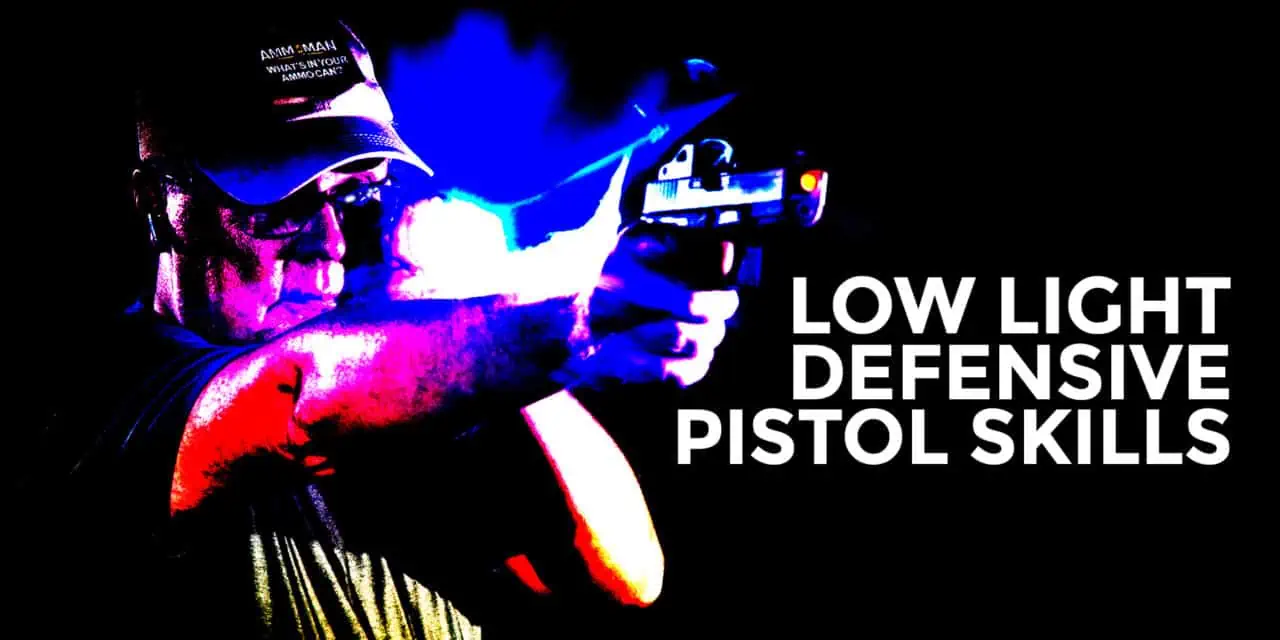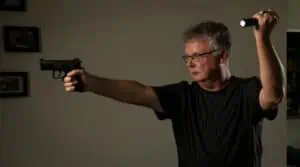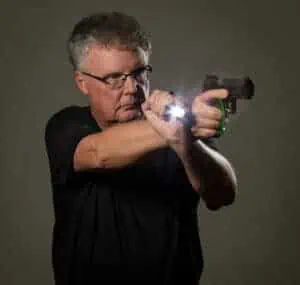The Basics of Low Light Shooting Drills
Humans figured out early on that night vision just wasn’t our thing. Even worse, a lot of the animals who wanted to eat us could see rather well at night. Something needed to be done if we were going to make it as a species, and that something was taming the power of fire and using it to light up the night and scare off the predators around us.
Humans have gotten better and better at this sort of thing over the millennia, to the point where we have tactical flashlights that can light up the night and be used to blind and bedazzle our opponent. However, it takes skill in order to exploit the power of a tactical flashlight to its fullest, especially when used in conjunction with a defensive pistol. We’re going to take a look at some common defensive flashlight techniques as well as some low light shooting drills to help you better integrate a flashlight into the concealed carry lifestyle.
Let’s start with the obvious: Some form of tactical flashlight is an absolutely essential part of your personal security gear. They are useful in so many ways besides self-defense and can be carried into locations where any sort of “weapon” would be strictly off-limits. A flashlight helps you find your way to your car at night, and it can help you find your car keys if you’ve dropped. If you carry a gun and don’t carry a flashlight, change that right now. It’s that important.
Do Low Light Shooting Drills Apply To The Armed Citizens?
We talked with legendary lawman and noted firearms trainer Chuck Haggard to get a better idea of how flashlights work and don’t work for the armed citizen. We also got some tips from him about what kind of low light shooting drills would be best for those of us who carry a gun on a regular basis.
“First, we have to understand that the mission of law enforcement and the mission of the armed citizen are two different things,” Haggard said. “This is going to affect how an armed citizen uses a flashlight. Tom Givens has said that for the armed civilian, there is no such thing as ‘street crime.’ Rather, there is ‘parking lot crime.’ 62 of his students have won gunfights, and none of them used a flashlight when they defended their lives. Is a flashlight important? Absolutely. But remember, it’s the job of law enforcement to chase down the bad guy, not ours, so the chances are low that an armed citizen will need to use a flashlight with their gun outside of their home.”
Light Up The Night
“However, a flashlight is an extremely useful thing to have both inside and outside the home,” Haggard continued. “Outside of the home, using a flashlight in a low light situation sends a clear signal to any bad guys around that you’re aware of your surroundings and you’re aware there might be trouble present. This makes them think twice about attacking you, and you’ve won that fight before it even started.”
“Inside of the home,” Haggard went on to say, “a flashlight is absolutely vital for positive target identification. We all hear the news stories about how an armed homeowner shot a relative or a loved one by mistake, and having a flashlight with you greatly reduces the chances of that tragic outcome. Every gun you use for home defense should be paired with a handheld light of some kind.”
At first glance, a weapon-mounted light would solve many of these problems. It’s right there on your gun, pointed in the same direction your muzzle is pointing. However, as you move through your home to see what that bump in the night was, that light and the muzzle of your gun are going to be pointed at some things you probably don’t want to shoot. Keep your gun at low ready or some other safe direction, and either use the spill from a weapon-mounted light that’s pointed in a safe direction or use a separate flashlight to find your way around. A weapon-mounted light is there to light up something you know is a target. It should not be pointed at something that isn’t a target.
How To Hold A Flashlight With A Pistol
A good low light shooting drill to practice this scenario would be to move through your house at night with a “blue gun” and a flashlight and see how this affects your perception. Objects that are unnoticed and unobtrusive in the daylight can suddenly cast hard shadows and conceal ambush spots when lit up with a flashlight at night.
We’ll go into weapon light techniques in another post. For now, let’s talk about how to use a pistol with a separate flashlight and what sort of low light drills might be best for an armed citizen.
Let’s begin with the obvious: If you have one hand on a flashlight, you can only have one hand on your pistol. This means that the normal two-handed grip isn’t going to work. It also means we need to make adjustments and learn how to bring both our flashlight and pistol into the fight when needed.
FBI Flashlight Technique
The first method we’ll look at is the FBI technique. The flashlight is held in your non-dominant hand (the left hand, for right-handed shooters) and held away from the body, either off to one side or up in the air at a diagonal. The idea here is that the light from the flashlight will draw attention and draw incoming fire, so it’s best to have your light away from your body if that happens.
Critics of the FBI technique say that it’s difficult, if not impossible, to point both your flashlight and your pistol at the target if you need to shoot. However, based on my experience at Gunsite, it’s not that hard to aim both at the target on demand. Other drawbacks are that it’s tiring to hold your flashlight above or to the side of your body for extended periods of time, and it forces you to hold your gun one-handed.
Neck Index Technique
The neck index technique (or head technique) is another way of keeping your flashlight on-target during a low-light shooting drill. The pistol is once again held in one hand, but this time, the flashlight is pressed against either the side of the neck or head with the non-dominant hand. This means that the flashlight moves as your head moves, which is really useful in a low-light environment.
There are, however, drawbacks to this method. The first is your flashlight is now right up against your head, so if your light draws incoming fire, chances are those incoming rounds are going to hit something that’s very important to you. The other drawbacks of this technique is that it also requires one-handed shooting, and having the light behind your pistol means you can have too much light on your gun and not enough on your target.
Harries Flashlight Technique
The third method is called the Harries technique. This differs from the other two methods in that it’s a two-handed technique. The flashlight is held in the non-dominant hand, which is then placed underneath the hand with the pistol and locked into place. This gives you a more stable firing position than just using one hand, and keeps both the flashlight and the gun pointed in generally the same direction.
With the Harries technique, you can avoid pointing your muzzle at things you shouldn’t by angling your wrist down. This technique has the same problem as the neck index technique in that your flashlight is in front of your head and body, and if the light draws any fire, chances are those rounds are going to hurt.
Practice Regularly, Practice Safely
Practicing low light shooting drills can be a bit of a problem for the armed citizen. The average indoor range is adverse to turning off the lights when you’re shooting, and finding an outdoor range that allows you to practice at night can be a bit of a task.
However, it’s important to remember that the point of these low light shooting drills isn’t to learn how bright your flashlight really is. That you can learn at home, on your own time. Rather, the point of this is to help you make the shot when it matters with your flashlight in your hand, and that’s something you can practice at your local range. Shoot each method and see how they affect your accuracy at common, across the room distances. Then make them a regular part of your practice routine, because you’re not going to rise to the occasion when it really counts. Rather, you’re going to fall to your lowest level of practice. Make sure your practice counts.






